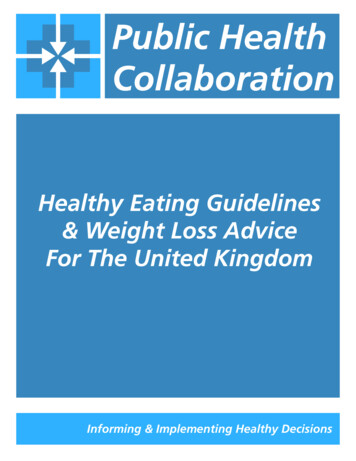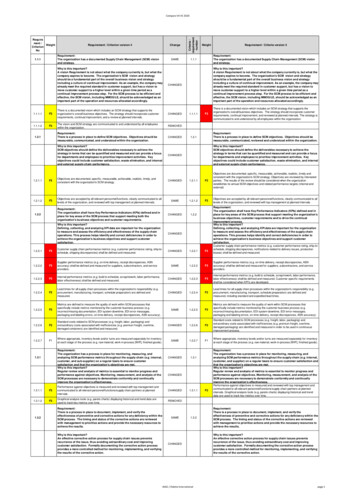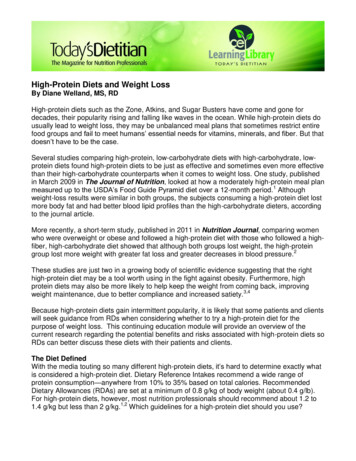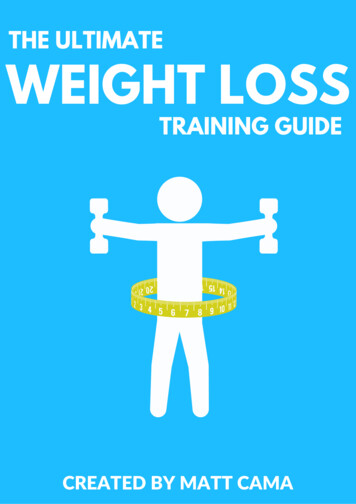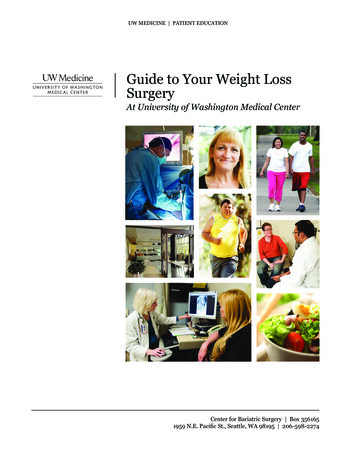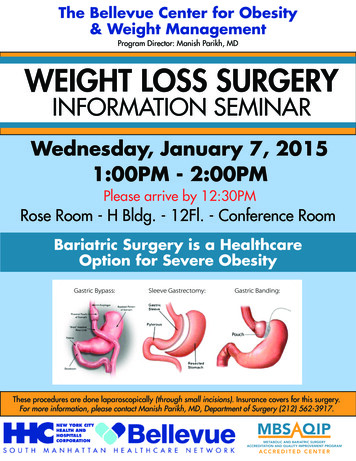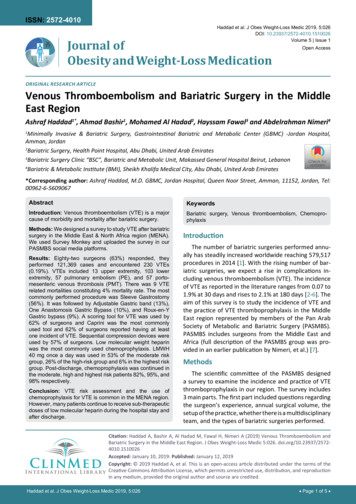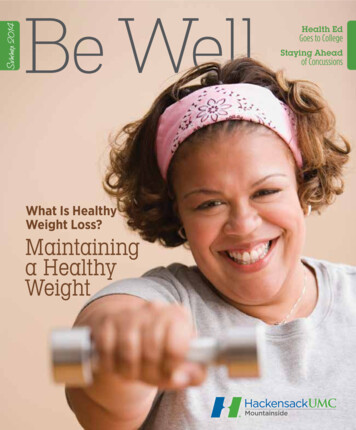
Transcription
Summer 2014Health EdGoes to CollegeStaying Aheadof ConcussionsWhat Is HealthyWeight Loss?Maintaininga HealthyWeight
A Speedier RecoverySUMMER 2014 2Good News!Since our last edition of Be Well, therehas been an exciting development atHackensackUMC Mountainside: We’remaking enhancements that will havea significant impact on the quality andavailability of health care in this community.The large-scale projects we’re undertakinginclude construction of an on-campusmedical office building, installation of stateof-the-art equipment, new informationtechnology systems, and an aesthetic faceliftfor our lobby and other public spaces.All of these ongoing improvements—whichwill take a couple years to complete— arein alignment with our goal of providingconvenient access to world-class care. Infact, with a national shortage of physiciansin crucial primary care specialties looming,these projects will help us attract and retainthe very best doctors to practice locally.At this time of sweeping, unprecedentedchange throughout the healthcarecontinuum, we’re fortunate to be underthe stewardship of two highly regardedorganizations, LHP and the HackensackUniversity Health Network. With thisinfusion of investment capital, thesedynamic partners have ensured that ourhospital can continue its long, distinguishedtradition of service for years to come.Be Well,John A. Fromhold, FACHECEO, HackensackUMC MountainsideThis publication in no way seeks to serve as a substitutefor professional medical care. Consult your physicianbefore undertaking any form of medical treatment oradopting any exercise program or dietary guidelines.Sometimes patients need extra recoverytime after an illness or injury but do not needtraditional hospital care. The Transitional CareUnit at HackensackUMC Mountainside wasdesigned by doctors and nurses to help patientsprepare for the challenges of going home.“Our Transitional CareUnit has extraordinary,unique value,” saysBernard Reimer, MD,hospitalist, division chiefof Internal Medicineat HackensackUMCMountainside. “Throughoccupational therapyBernard Reimer, MDand social interaction,we help get patients home faster.”BACK TO LIFEPatients can be referred to the unit for avariety of health reasons, including recoveryafter a cardiac event or orthopedic surgery.Jane Debenedette, RN, same-day surgerynurse at HackensackUMC Mountainside,underwent a total knee replacement inOctober 2013 and stayed in the TransitionalCare Unit before returning home.“This unit is a great resource,” Jane says. “Thekey part of any joint replacement surgery isgetting the appropriate physical therapy, andFive-Star CareThe Transitional Care Unit (TCU)at HackensackUMC Mountainsidewas recognized with five stars inU.S. News & World Report’s sixthannual Best Nursing Homes forthe second year in a row.“I am so proud to be a part of ateam that has been honored for twoconsecutive years on a national level,”says Lisa Hertel, RNC, director ofSubAcute Services, HackensackUMCMountainside. “Each nursing homeis rated separately on quality ofcare, health inspections record, andlevel of nurse staffing. Our TCU has agreat staff that makes a difference inso many lives each day.”every morning I could see my schedule.Staff members would check in and take meto my occupational therapy appointments,where I practiced daily tasks, and then tophysical therapy. When I got home, I knewexactly how to do the exercises, so I couldcontinue strengthening my knee.”To learn more about all the levels of careavailable at HackensackUMC Mountainside,visit www.mountainsidehosp.com.
3 SUMMER 2014PrepIn the fall of 2014, an estimated 22 million students will head to college. Help your child confidently navigatethe newfound freedom and added pressures of higher education by talking about how to stay well at school.NOT ‘JUST A DRINK’Parents’ rules for underage drinking make a difference. Teens withparents who disapprove of their drinking are less likely to binge drinkor make risky drinking-related choices when away at school.Talk with your child about drinking early in the teen years. Drinkingalcohol can jeopardize academic performance and cause users todevelop depression, liver disease, and other problems. In young adultsage 18 to 24, alcohol is involved in 97,000 sexual assaults and almost600,000 unintentional injuries each year.Be honest about the consequences and discuss strategies for drinkingin moderation. Teach your teen skills, such as resisting peer pressureand designating a sober driver, to manage high-risk situations.A STARTLING PROBLEMApproximately 25 percent of college-aged women have eatingdisorders, conditions where an unhealthy relationship with food andbody image lead to overeating (binging), avoiding food (anorexia),or purging food through self-induced vomiting or misuse ofmedication (bulimia).Instill good self-esteem and healthful eating habits in young adultsfrom an early age. Build a college meal plan together and watch forsigns of eating disorders, such as behavioral changes, food obsession,and not eating around others.YOUR BEST SHOTClose living quarters and communal spaces are breeding grounds forhealth problems such as meningococcal meningitis, a nervous systeminfection. Dorm-dwelling college freshmen are at risk of developingthis disease that can cause brain damage, hearing loss, and even death.Follow the Centers for Disease Control and Prevention immunizationguidelines and make sure your child receives the meningococcal vaccineat least once. Each dose provides five years of protection.To make a “pre-college” checkup appointment with a HackensackUMCMountainside physician, call 888.973.4674 or n and YouthAddiction can begin at any age, but young peopleare a particularly high-risk group because they arestill developing their personalities and judgment.“As a parent, communication is the strongest tool inyour arsenal for combating addiction,” says KennethFaistl, MD, FAAFP, Family Practice program directorfor HackensackUMC Mountainside. “Open those linesKenneth Faistl, MDof communication when children are young and keepthem open. Know your children’s friends, know where they are, and encouragechildren to participate in structured programs such as sports.”
TIPPINSUMMER 2014 4thewith SurgeryMorebleD adjustaNALAP-Bgindnagastric bormeds are perfecpro dureckUMCsanat Hackeraeyhceaanyside thanMountainr intenecicatrother bariey.New JersYou’ve tried everything to reach a healthy weight, bto consider a more aggressive approach?More than 78 million Americans struggle withobesity. Some of them have found success throughlifestyle changes alone. But not all obesity is the same,and not all approaches to weight management workfor everyone.“Most people who make ideal candidates for surgicalweight loss have struggled with weight their entirelives,” says Karl Strom, MD, medical director ofthe Center for Advanced Bariatric Surgery atHackensackUMC Mountainside. “The longer thatweight stays on, the more difficult it is to lose.”A LONG-TERM SOLUTION FORA LIFELONG PROBLEMAccording to Dr. Strom, people with long-standingweight issues are less likely to find success withpopular diet programs. These people often lose asignificant amount of weight—as much as 50 pounds ormore—but gain it all back within a short time followingthe program. Beyond feeling frustrated and discouraged,this “seesaw” effect does nothing to prevent commoncomplications of obesity, such as heart disease, Type 2diabetes, stroke, certain cancers, and fertility problems.“For these patients, I don’tconsider surgery to be a lastresort,” Dr. Strom says. “Infact, they should considersurgery sooner rather thanlater, as early action is keyto reducing mortality fromsecondary diseases.”Karl Strom, MDBariatric surgery is a medically proven treatmentfor obesity and offers the same health benefitsas conservative weight-loss measures. According toDr. Strom, bariatric surgery can actually cure Type 2 diabetes.
e Scalesbut nothing seems to work. Is it timeIf you have excess weight, you may be at risk for developing Type 2diabetes, which means your body cannot produce enough insulin toconvert food into energy.Uzma Shafqat, MD“Eating a diet high in fatty and sugary foods and drinks make cells inthe body insulin resistant, an early warning sign of metabolic disease,”says Uzma Shafqat, MD, endocrinologist with Mountainside MedicalGroup. “Obesity and diabetes share several risk factors, such as lackof exercise and a high-calorie diet.”As Dr. Shafqat notes, your risk of developing diabetes increasesproportionately to the amount of excess weight you gain. People with a body mass index(BMI) between 25 and 29.9 are at risk for diabetes, and those with a higher BMI areconsidered at high risk. Having a large waistline is also a contributing factor in metabolicsyndrome, which is considered a precursor to diabetes.To learn more about working with a Mountainside Medical Group physician to understand yourrisks, please visit www.mountainsidedocs.com.“If you can control obesity, other relateddiseases may resolve,” Dr. Strom says. “I encouragepeople to be proactive in treating obesity sothey can avoid these complications altogether.”WHICH TYPE IS RIGHT FOR ME?The most common forms of bariatric surgery include:What Is Healthy Weight Loss? Adjustable gastric banding (LAP-BAND)—Every year, countless Americans attempt to lose weight with crashdiets that promise rapid weight loss in a short amount of time.An adjustable belt is fastened around the upperpart of the stomach, creating a small upperpouch that helps patients feel full with less food.Weight loss is slow and steady. Sleeve gastrectomy—A large portion of thestomach is surgically removed, leaving anarrow “sleeve” that restricts the amount offood patients can eat at one time. Weight lossis fast initially, then gradually slows down. Roux-en-Y gastric bypass—A small portionof the stomach is attached directly to thesmall intestine, and the duodenum and upperintestine are bypassed. Because this procedureaffects the body’s ability to absorb nutrientsand minerals from food, patients have to takedietary supplements for the rest of their lives.Each procedure has its own advantages anddisadvantages. Discussing these procedureswith a bariatric surgeon will help you decidewhich option is best for you.Are you ready for weight-loss surgery?If you have a BMI of 40 or higher, or 35or higher with at least one related healthcondition, you may qualify for surgery.Visit www.mountainsidehosp.com/bariatrics.Katharine Palla, DO“These super-restrictive diets produce results on the scale, but whatpeople are actually losing is water weight,” says Katharine Palla, DO,internal medicine physician with Mountainside Medical Group. “Crashdiets don’t actually change your body fat composition or promotesustainable weight loss. They reinforce an unhealthy ‘all or nothing’ wayof thinking.”Dr. Palla recommends a healthy approach to weight loss, which involves: making small, gradual lifestyle changes you can live with for the rest of your life incorporating several strategies at once, including dietary changes, exercise, and medicationwhen appropriate not starving yourself, restricting healthy foods, or cutting out entire food groups focusing on the health benefits and sense of well-being you gain from weight loss, ratherthan numbers on the scale SUMMER 2014NGDiabetes and Your Weight5
AheadProtect your child’s brain from the pain and dangerof head injuries. Every year, nearly 250,000 children are treated for a concussion ortraumatic brain injury (TBI). More than just a headache, even minorhead injuries can cause lasting damage—and the negative effects cancompound with each injury.Researchers have known for years that repeated head traumas resultin problems with memory and learning, and recent studies show thateven mild concussions have consequences that last as long as a year.The best way to stop the devastating impact of TBIs is to prevent them.ATTENTION COACHES, ATHLETICDIRECTORS, SCHOOL NURSES, ANDTRAINERS: INJURYIN SPORTSWhen choosing a helmet, consider: Size. The helmet should besnug and not rock from sideto side, but not be too tight.Try different padding sizes tomaximize comfort and fit. Position. The helmet shouldbe two finger-widths above theeyebrow and level on the top ofthe head. Chin strap. Center the leftbuckle under the chin, and youshould not be able to placemore than two fingers underthe strap.Certified. Buy helmetsapproved by the ConsumerProduct Safety Commission.Set a good example and make sure everyone in the family wearshelmets while riding bikes or skating together. Also, encourage kidsto pick out helmets they enjoy. Your child will be more likely to weara “cool” helmet.To find a physician who specializes in sports medicine atHackensackUMC Mountainside, call 888.973.4674.Concussion 101 Join us for an evening tailored to those working withchildren and adults in sports. Discussion will addressfollowing topics:theupper extremities, hip pain, and coissues in sports mmmonedicine. Thursday, June 12,at 6 p.m., at HackensackUMC Mountainside, Bayberry.For more information or to s.HELMETS MATTERIn New Jersey, anyone age 16 or younger who uses a bicycle, inlineskates, or skateboards must wear a helmet. Breaking the law can resultin fines—and damage to your child’s brain.Every concussion should be treated as a serious brain injury.Symptoms of concussion include: confusion or difficultyconcentrating problems rememberingnew information fuzzy or blurred vision nausea and dizziness irritability, sadness, or changesin emotional state headache“Someone with a suspected concussion needs to be seen by atrained healthcare provider immediately,” says Melissa Mascaro, MD,family practice and sports medicine physician at HackensackUMCMountainside. “If your child has a hard hit or exhibits symptomsof a concussion during a game or match, remove him from playimmediately and do not let him return to sports until after evaluationby a professional.”Proper training and good technique can protect the heads and necks of athletes inany sport, whether or not wearing a helmet is allowed. Additionally, players, coaches,and parents should learn to recognize the signs of head injury and concussion.—Melissa Mascaro, MD, family practice and sports medicine physician at HackensackUMC Mountainside SUMMER 2014 One Step 6
ADAYin the Life of aThe assistant is the da Vinci S HD SurgicalSystem, a robotic unit featuring wrists moredexterous than those of humans and threedimensional, high-definition optics that givethe surgeon—who controls the device from aconsole a few feet away—a spectacular view ofthe operating field.Twenty-three surgeons at HackensackUMCMountainside use da Vinci to perform a varietyof procedures, including those to treat kidneydisease, ovarian cysts, and bowel and lungcancers. The operations on the schedule todayare the most commonly performed da Vinciprocedures at HackensackUMC Mountainside:total hysterectomy and prostatectomy.HYSTERECTOMY WITH LESS HASSLEA 57-year-old teacher was recently diagnosedwith early-stage uterine cancer. The firststep in her treatment journey is removal ofthe uterus (hysterectomy). Many surgeonsperform hysterectomy laparoscopically—inserting a camera and surgical instrumentsthrough small incisions rather than making asingle large incision. Da Vinci improves uponthat minimally invasive approach.Surgical Artistmake incisions, see andcontrol bleeding, andplace stitches,” saysJames Saidi, MD, medicaldirector of Robotic Surgeryat HackensackUMCMountainside. “Theoperation is more precisethan laparoscopy, whichJames Saidi, MDtranslates to less bloodloss, fewer complications, and better outcomesfor patients.”ACCELERATING RECOVERYIn the mid-afternoon, da Vinci is readyfor its second case of the day. Traditionallaparoscopy isn’t an option for the 68-yearold retiree with prostate cancer. If he weren’ta candidate for minimally invasive da Vinciprostate removal, large-incision opensurgery would be the only option.“Da Vinci prostatectomy patients spend onlyone night in the hospital after surgerycompared to three nights for open surgerypatients,” Dr. Saidi says. “Best of all, da Vincipatients typically heal in three weeks insteadof six.”“The robotic system’s enhanced vision anddexterity make it easier for the surgeon toby the numbers:The da Vinci Surgical System20–25minutes232,966}neededto prepareda vinci fora procedureSURGEONSwith full robotic privileges atHackensackUMC Mountainsideda Vinci units were installed worldwideat the end of 2013.2,083 were located in the united states.approximatelyWant to learn more about da Vinci surgeryat HackensackUMC Mountainside? Visitwww.mountainsideroboticsurgery.com.523,000da Vinci proceduresperformed around theworld in 2013Source: James Saidi, MD, medical director ofRobotic Surgery at HackensackUMC Mountainside SUMMER 20147It’s 9 a.m. on a Tuesday at HackensackUMC Mountainside, anda four-armed surgery assistant is preparing for work.
Z IP CO24 5 0 6M AILEDOMDEFRPRSRT STDU.S. PostagePAIDPermit No. 8301 Bay Ave.Montclair, NJ 07042Dance Your Way to a Healthy Heart.on Father’s Day!With HackensackUMC Mountainside and Arthur Murray Dance Center of Montclair.Date:Time:Location:Sunday, June 155 pm - 8 pmMontclair Art Museum3 South Mountain AveMontclair, NJ 07042 15 Admission FeeAll proceeds will be donated toThe American Heart Association.Light refreshments will be provided.To register, please call 1 (888) 973-4MSH or visit www.mountainsidehosp.com/hearthealthArthur Murray dance professionalswill teach various dances.
annual Best Nursing Homes for the second year in a row. “I am so proud to be a part of a team that has been honored for two consecutive years on a national level,” says Lisa Hertel, RNC, director of SubAcute Services, HackensackUMC Mountainside. “Each nursing home is rated sepa
